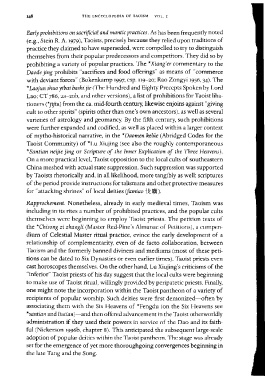Page 188 - The Encyclopedia of Taoism v1_A-L
P. 188
148 THE ENCYCLOPEDIA OF TAOISM VOL. I
Early prohibitions on sacrificial and man tic practices. As has been frequently noted
(e.g., Stein R. A. 1979), Taoists, precisely because they relied upon traditions of
practice they claimed to have superseded, were compelled to try to distinguish
themselves from their popular predecessors and competitors. They did so by
prohibiting a variety of popular practices. The *Xiang'er commentary to the
Daode jing prohibits "sacrifices and food offerings" as means of "commerce
with deviant forces" (Bokenkamp 1997, esp. 119-20; Rao Zongyi 1956,34). The
*Laojun shuo yibai bashi jie (The Hundred and Eighty Precepts Spoken by Lord
Lao; CT 786, 2a-20b, and other versions), a list of prohibitions for Taoist liba-
tioners (*jijiu) from the ca. mid-fourth century, likewise enjoins against "giving
cult to other spirits" (spirits other than one's own ancestors), as well as several
varieties of astrology and geomancy. By the fifth century, such prohibitions
were further expanded and codified, as well as placed within a larger context
of mytho-historical narrative, in the *Daomen keliie (Abridged Codes for the
Taoist Community) of *Lu Xiujing (see also the roughly contemporaneous
*Santian neijie jing or Scripture of the Inner Explication of the Three Heavens).
On a more practical level, Taoist opposition to the local cults of southeastern
China meshed with actual state suppression. Such suppression was supported
by Taoists rhetorically and, in all likelihood, more tangibly as well: scriptures
of the period provide instructions for talismans and other protective measures
for "attacking shrines" of local deities (jamiao i.l(;JWl).
Rapprochement. Nonetheless, already in early medieval times, Taoism was
including in its rites a number of prohibited practices, and the popular cults
themselves were beginning to employ Taoist priests. The petition texts of
the *Chisong zi zhangli (Master Red-Pine's Almanac of Petitions), a compen-
dium of Celestial Master ritual practice, evince the early development of a
relationship of complementarity, even of de facto collaboration, between
Taoism and the formerly banned diviners and mediums (most of these peti-
tions can be dated to Six Dynasties or even earlier times). Taoist priests even
cast horoscopes themselves. On the other hand, Lu Xiujing's criticisms of the
"inferior" Taoist priests of his day suggest that the local cults were beginning
to make use of Taoist ritual, willingly provided by peripatetic priests. Finally,
one might note the incorporation within the Taoist pantheon of a variety of
recipients of popular worship. Such deities were first demonized-often by
associating them with the Six Heavens of *Fengdu (on the Six Heavens see
*santian and liutian)-and then offered advancement in the Taoist otherworldly
administration if they used their powers in service of the Dao and its faith-
ful (Nickerson 1996b, chapter 8). This anticipated the subsequent large-scale
adoption of popular deities within the Taoist pantheon. The stage was already
set for the emergence of yet more thoroughgoing convergences beginning in
the late Tang and the Song.

